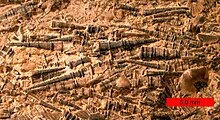| Tentaculites Temporal range: | |
|---|---|
 | |
| Tentaculitids from the Devonian of Maryland. | |
| Scientific classification | |
| Domain: | Eukaryota |
| Kingdom: | Animalia |
| Class: | † Tentaculita |
| Order: | † Tentaculitida |
| Family: | † Tentaculitidae |
| Genus: | † Tentaculites von Schlotheim, 1820 |
| Species | |
| |
Tentaculites is an extinct genus of conical fossils of uncertain affinity, class Tentaculita, although it is not the only member of the class. It is known from Lower Ordovician to Upper Devonian deposits [1] both as calcitic shells with a brachiopod-like microstructure [2] and carbonaceous 'linings'. [3] [4] The "tentaculites" (i.e. tentaculita) are also referred to as the styliolinids.


